Understanding Childhood Constructs and Their Impacts
VerifiedAdded on 2021/04/17
|10
|2658
|34
AI Summary
This assignment delves into the various constructs of childhood, including innocent, spoilt, uncontrollable, and evil children. It examines the differences between these constructs and their potential effects on future behavior, such as leading to negative opinions towards authority figures or engaging in violent activities. The importance of childhood experiences in shaping adult behaviors is highlighted, with a focus on how parents can guide children towards positive development.
Contribute Materials
Your contribution can guide someone’s learning journey. Share your
documents today.
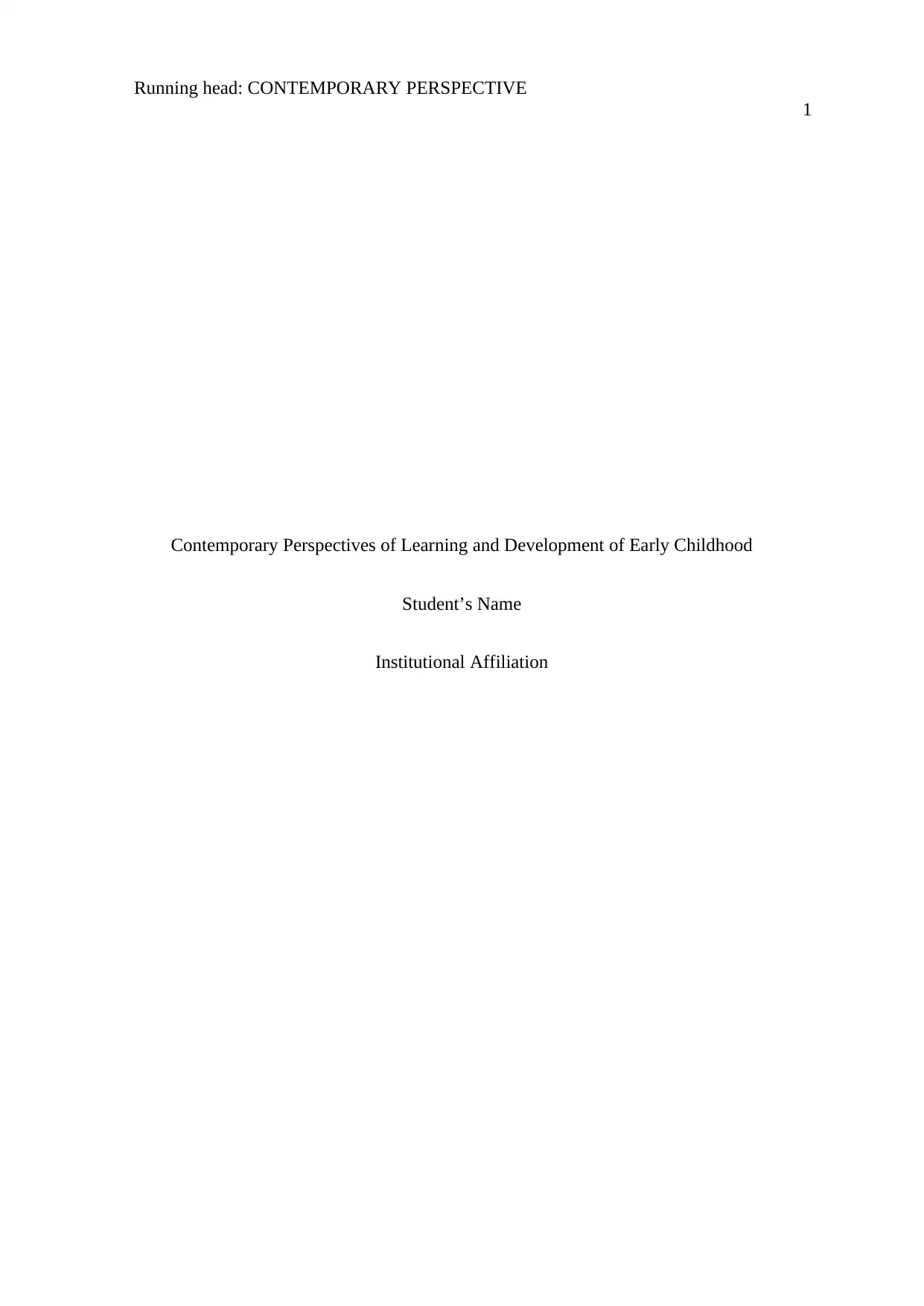
Running head: CONTEMPORARY PERSPECTIVE
1
Contemporary Perspectives of Learning and Development of Early Childhood
Student’s Name
Institutional Affiliation
1
Contemporary Perspectives of Learning and Development of Early Childhood
Student’s Name
Institutional Affiliation
Secure Best Marks with AI Grader
Need help grading? Try our AI Grader for instant feedback on your assignments.
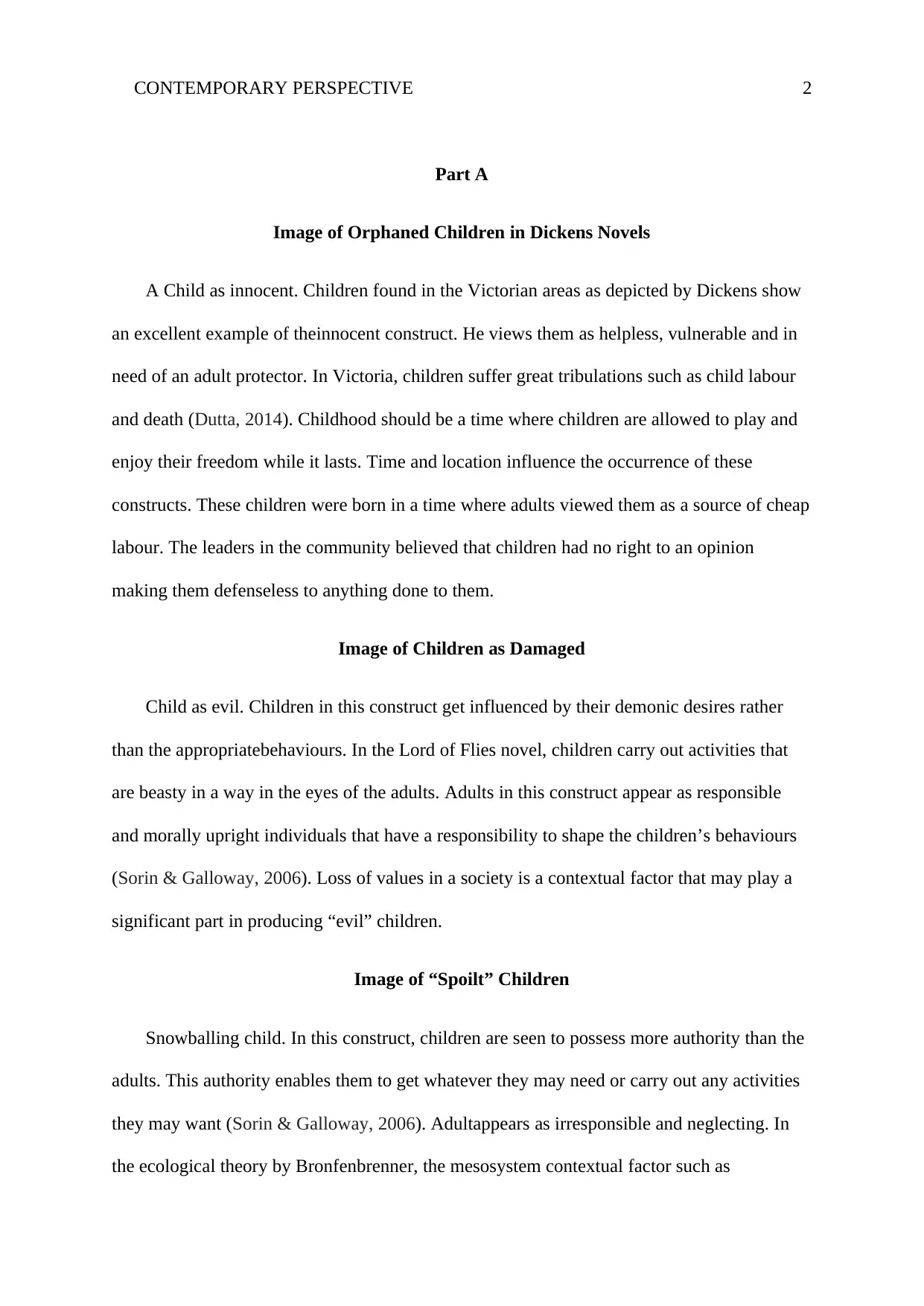
CONTEMPORARY PERSPECTIVE 2
Part A
Image of Orphaned Children in Dickens Novels
A Child as innocent. Children found in the Victorian areas as depicted by Dickens show
an excellent example of theinnocent construct. He views them as helpless, vulnerable and in
need of an adult protector. In Victoria, children suffer great tribulations such as child labour
and death (Dutta, 2014). Childhood should be a time where children are allowed to play and
enjoy their freedom while it lasts. Time and location influence the occurrence of these
constructs. These children were born in a time where adults viewed them as a source of cheap
labour. The leaders in the community believed that children had no right to an opinion
making them defenseless to anything done to them.
Image of Children as Damaged
Child as evil. Children in this construct get influenced by their demonic desires rather
than the appropriatebehaviours. In the Lord of Flies novel, children carry out activities that
are beasty in a way in the eyes of the adults. Adults in this construct appear as responsible
and morally upright individuals that have a responsibility to shape the children’s behaviours
(Sorin & Galloway, 2006). Loss of values in a society is a contextual factor that may play a
significant part in producing “evil” children.
Image of “Spoilt” Children
Snowballing child. In this construct, children are seen to possess more authority than the
adults. This authority enables them to get whatever they may need or carry out any activities
they may want (Sorin & Galloway, 2006). Adultappears as irresponsible and neglecting. In
the ecological theory by Bronfenbrenner, the mesosystem contextual factor such as
Part A
Image of Orphaned Children in Dickens Novels
A Child as innocent. Children found in the Victorian areas as depicted by Dickens show
an excellent example of theinnocent construct. He views them as helpless, vulnerable and in
need of an adult protector. In Victoria, children suffer great tribulations such as child labour
and death (Dutta, 2014). Childhood should be a time where children are allowed to play and
enjoy their freedom while it lasts. Time and location influence the occurrence of these
constructs. These children were born in a time where adults viewed them as a source of cheap
labour. The leaders in the community believed that children had no right to an opinion
making them defenseless to anything done to them.
Image of Children as Damaged
Child as evil. Children in this construct get influenced by their demonic desires rather
than the appropriatebehaviours. In the Lord of Flies novel, children carry out activities that
are beasty in a way in the eyes of the adults. Adults in this construct appear as responsible
and morally upright individuals that have a responsibility to shape the children’s behaviours
(Sorin & Galloway, 2006). Loss of values in a society is a contextual factor that may play a
significant part in producing “evil” children.
Image of “Spoilt” Children
Snowballing child. In this construct, children are seen to possess more authority than the
adults. This authority enables them to get whatever they may need or carry out any activities
they may want (Sorin & Galloway, 2006). Adultappears as irresponsible and neglecting. In
the ecological theory by Bronfenbrenner, the mesosystem contextual factor such as
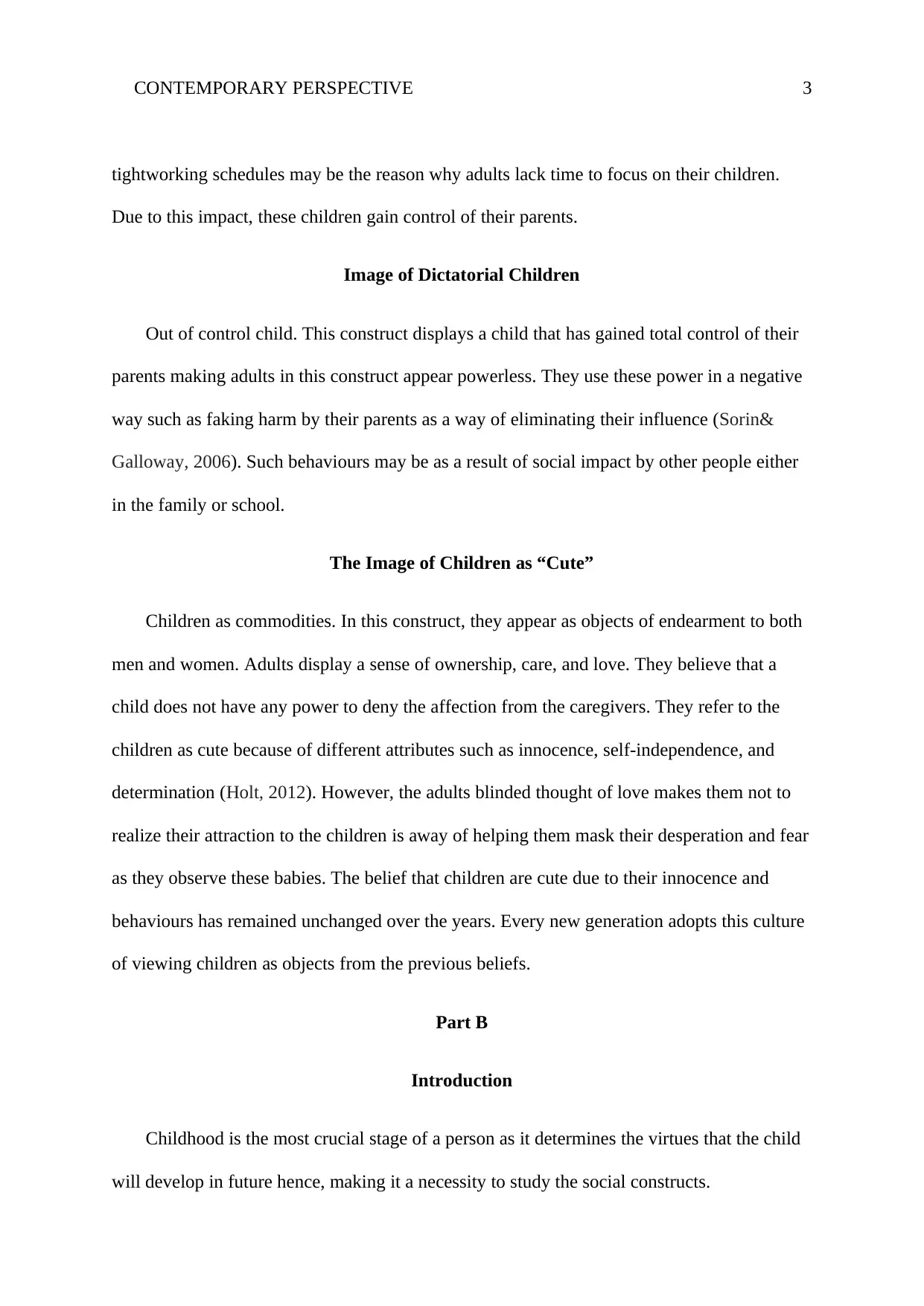
CONTEMPORARY PERSPECTIVE 3
tightworking schedules may be the reason why adults lack time to focus on their children.
Due to this impact, these children gain control of their parents.
Image of Dictatorial Children
Out of control child. This construct displays a child that has gained total control of their
parents making adults in this construct appear powerless. They use these power in a negative
way such as faking harm by their parents as a way of eliminating their influence (Sorin&
Galloway, 2006). Such behaviours may be as a result of social impact by other people either
in the family or school.
The Image of Children as “Cute”
Children as commodities. In this construct, they appear as objects of endearment to both
men and women. Adults display a sense of ownership, care, and love. They believe that a
child does not have any power to deny the affection from the caregivers. They refer to the
children as cute because of different attributes such as innocence, self-independence, and
determination (Holt, 2012). However, the adults blinded thought of love makes them not to
realize their attraction to the children is away of helping them mask their desperation and fear
as they observe these babies. The belief that children are cute due to their innocence and
behaviours has remained unchanged over the years. Every new generation adopts this culture
of viewing children as objects from the previous beliefs.
Part B
Introduction
Childhood is the most crucial stage of a person as it determines the virtues that the child
will develop in future hence, making it a necessity to study the social constructs.
tightworking schedules may be the reason why adults lack time to focus on their children.
Due to this impact, these children gain control of their parents.
Image of Dictatorial Children
Out of control child. This construct displays a child that has gained total control of their
parents making adults in this construct appear powerless. They use these power in a negative
way such as faking harm by their parents as a way of eliminating their influence (Sorin&
Galloway, 2006). Such behaviours may be as a result of social impact by other people either
in the family or school.
The Image of Children as “Cute”
Children as commodities. In this construct, they appear as objects of endearment to both
men and women. Adults display a sense of ownership, care, and love. They believe that a
child does not have any power to deny the affection from the caregivers. They refer to the
children as cute because of different attributes such as innocence, self-independence, and
determination (Holt, 2012). However, the adults blinded thought of love makes them not to
realize their attraction to the children is away of helping them mask their desperation and fear
as they observe these babies. The belief that children are cute due to their innocence and
behaviours has remained unchanged over the years. Every new generation adopts this culture
of viewing children as objects from the previous beliefs.
Part B
Introduction
Childhood is the most crucial stage of a person as it determines the virtues that the child
will develop in future hence, making it a necessity to study the social constructs.
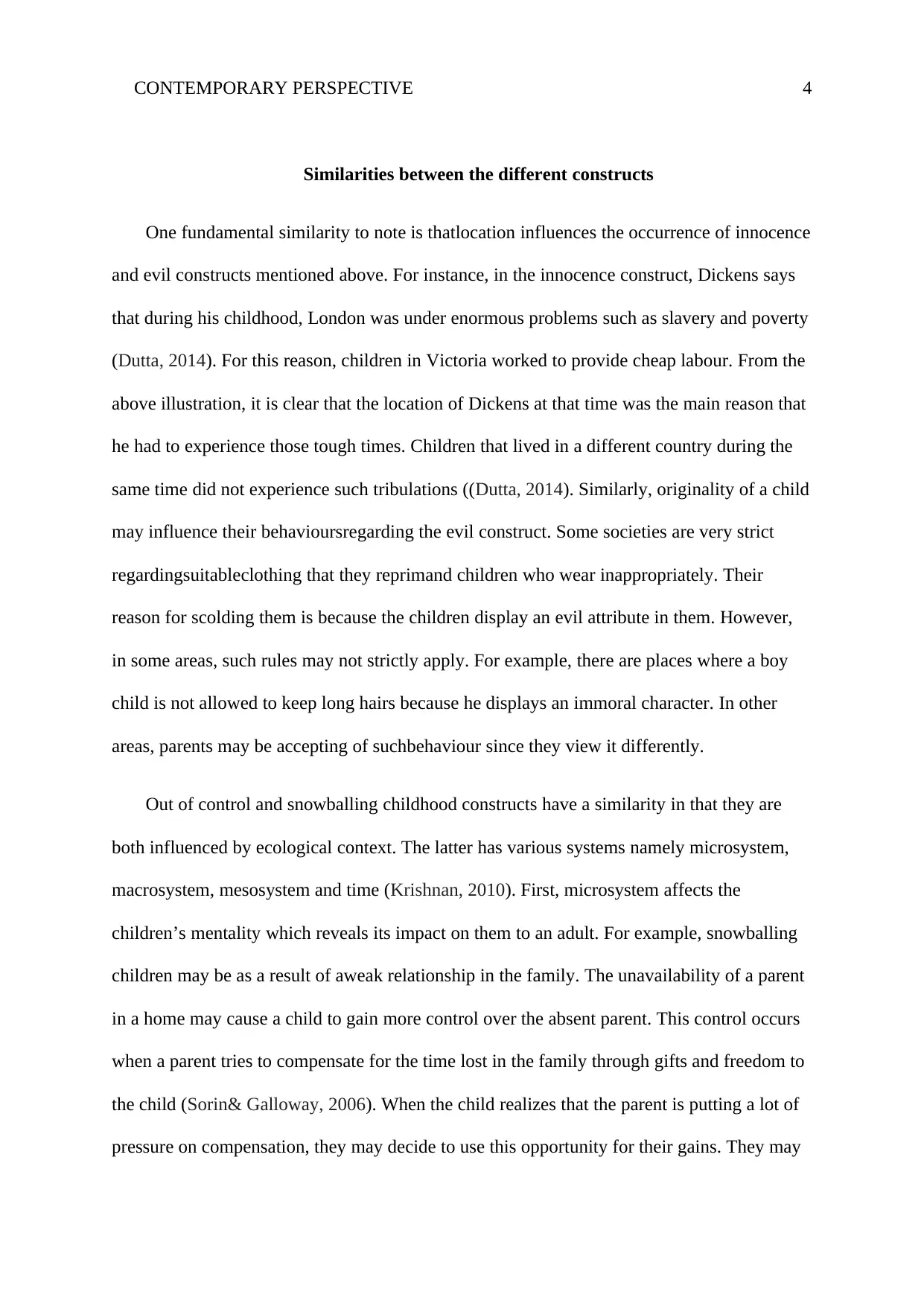
CONTEMPORARY PERSPECTIVE 4
Similarities between the different constructs
One fundamental similarity to note is thatlocation influences the occurrence of innocence
and evil constructs mentioned above. For instance, in the innocence construct, Dickens says
that during his childhood, London was under enormous problems such as slavery and poverty
(Dutta, 2014). For this reason, children in Victoria worked to provide cheap labour. From the
above illustration, it is clear that the location of Dickens at that time was the main reason that
he had to experience those tough times. Children that lived in a different country during the
same time did not experience such tribulations ((Dutta, 2014). Similarly, originality of a child
may influence their behavioursregarding the evil construct. Some societies are very strict
regardingsuitableclothing that they reprimand children who wear inappropriately. Their
reason for scolding them is because the children display an evil attribute in them. However,
in some areas, such rules may not strictly apply. For example, there are places where a boy
child is not allowed to keep long hairs because he displays an immoral character. In other
areas, parents may be accepting of suchbehaviour since they view it differently.
Out of control and snowballing childhood constructs have a similarity in that they are
both influenced by ecological context. The latter has various systems namely microsystem,
macrosystem, mesosystem and time (Krishnan, 2010). First, microsystem affects the
children’s mentality which reveals its impact on them to an adult. For example, snowballing
children may be as a result of aweak relationship in the family. The unavailability of a parent
in a home may cause a child to gain more control over the absent parent. This control occurs
when a parent tries to compensate for the time lost in the family through gifts and freedom to
the child (Sorin& Galloway, 2006). When the child realizes that the parent is putting a lot of
pressure on compensation, they may decide to use this opportunity for their gains. They may
Similarities between the different constructs
One fundamental similarity to note is thatlocation influences the occurrence of innocence
and evil constructs mentioned above. For instance, in the innocence construct, Dickens says
that during his childhood, London was under enormous problems such as slavery and poverty
(Dutta, 2014). For this reason, children in Victoria worked to provide cheap labour. From the
above illustration, it is clear that the location of Dickens at that time was the main reason that
he had to experience those tough times. Children that lived in a different country during the
same time did not experience such tribulations ((Dutta, 2014). Similarly, originality of a child
may influence their behavioursregarding the evil construct. Some societies are very strict
regardingsuitableclothing that they reprimand children who wear inappropriately. Their
reason for scolding them is because the children display an evil attribute in them. However,
in some areas, such rules may not strictly apply. For example, there are places where a boy
child is not allowed to keep long hairs because he displays an immoral character. In other
areas, parents may be accepting of suchbehaviour since they view it differently.
Out of control and snowballing childhood constructs have a similarity in that they are
both influenced by ecological context. The latter has various systems namely microsystem,
macrosystem, mesosystem and time (Krishnan, 2010). First, microsystem affects the
children’s mentality which reveals its impact on them to an adult. For example, snowballing
children may be as a result of aweak relationship in the family. The unavailability of a parent
in a home may cause a child to gain more control over the absent parent. This control occurs
when a parent tries to compensate for the time lost in the family through gifts and freedom to
the child (Sorin& Galloway, 2006). When the child realizes that the parent is putting a lot of
pressure on compensation, they may decide to use this opportunity for their gains. They may
Secure Best Marks with AI Grader
Need help grading? Try our AI Grader for instant feedback on your assignments.
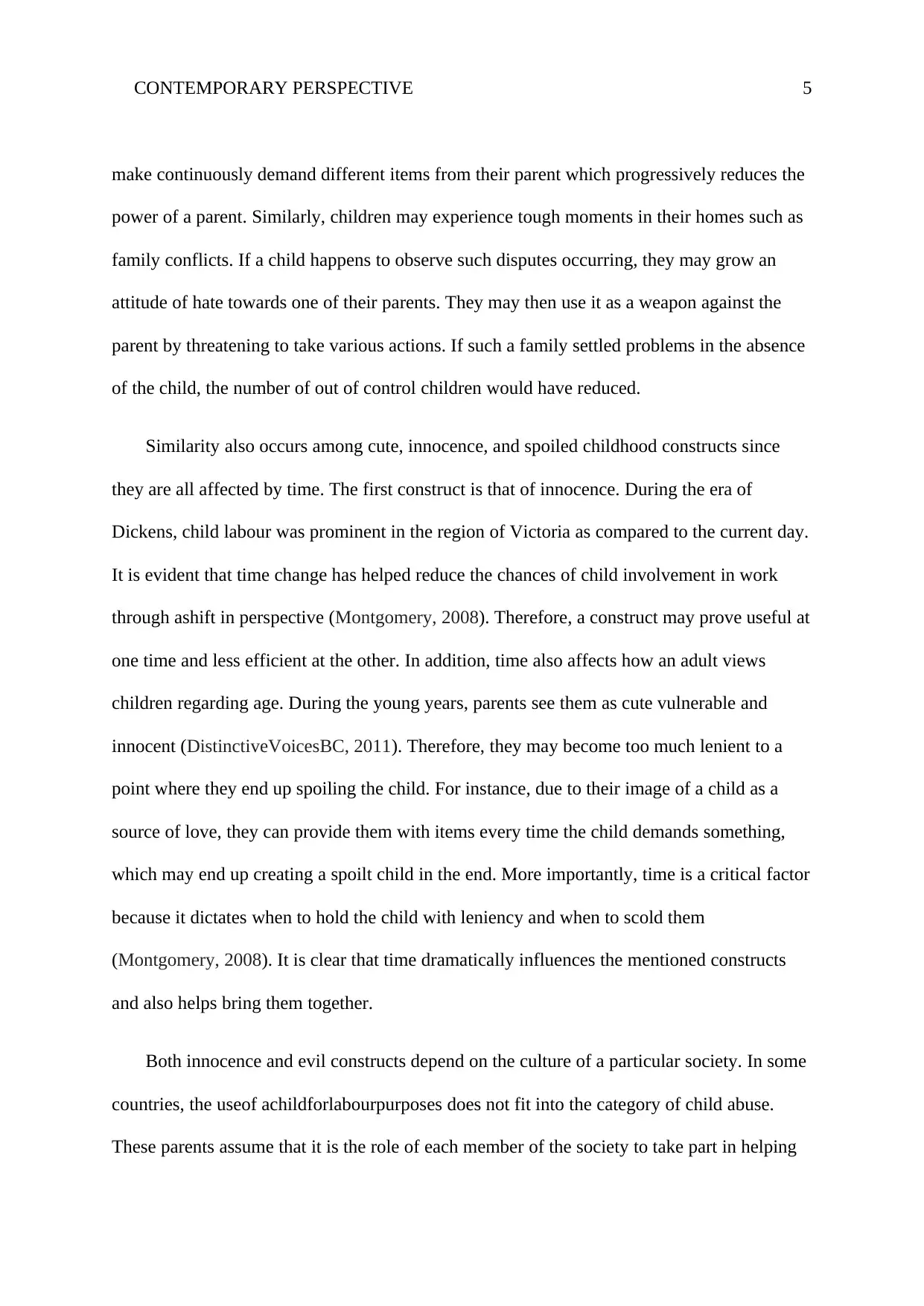
CONTEMPORARY PERSPECTIVE 5
make continuously demand different items from their parent which progressively reduces the
power of a parent. Similarly, children may experience tough moments in their homes such as
family conflicts. If a child happens to observe such disputes occurring, they may grow an
attitude of hate towards one of their parents. They may then use it as a weapon against the
parent by threatening to take various actions. If such a family settled problems in the absence
of the child, the number of out of control children would have reduced.
Similarity also occurs among cute, innocence, and spoiled childhood constructs since
they are all affected by time. The first construct is that of innocence. During the era of
Dickens, child labour was prominent in the region of Victoria as compared to the current day.
It is evident that time change has helped reduce the chances of child involvement in work
through ashift in perspective (Montgomery, 2008). Therefore, a construct may prove useful at
one time and less efficient at the other. In addition, time also affects how an adult views
children regarding age. During the young years, parents see them as cute vulnerable and
innocent (DistinctiveVoicesBC, 2011). Therefore, they may become too much lenient to a
point where they end up spoiling the child. For instance, due to their image of a child as a
source of love, they can provide them with items every time the child demands something,
which may end up creating a spoilt child in the end. More importantly, time is a critical factor
because it dictates when to hold the child with leniency and when to scold them
(Montgomery, 2008). It is clear that time dramatically influences the mentioned constructs
and also helps bring them together.
Both innocence and evil constructs depend on the culture of a particular society. In some
countries, the useof achildforlabourpurposes does not fit into the category of child abuse.
These parents assume that it is the role of each member of the society to take part in helping
make continuously demand different items from their parent which progressively reduces the
power of a parent. Similarly, children may experience tough moments in their homes such as
family conflicts. If a child happens to observe such disputes occurring, they may grow an
attitude of hate towards one of their parents. They may then use it as a weapon against the
parent by threatening to take various actions. If such a family settled problems in the absence
of the child, the number of out of control children would have reduced.
Similarity also occurs among cute, innocence, and spoiled childhood constructs since
they are all affected by time. The first construct is that of innocence. During the era of
Dickens, child labour was prominent in the region of Victoria as compared to the current day.
It is evident that time change has helped reduce the chances of child involvement in work
through ashift in perspective (Montgomery, 2008). Therefore, a construct may prove useful at
one time and less efficient at the other. In addition, time also affects how an adult views
children regarding age. During the young years, parents see them as cute vulnerable and
innocent (DistinctiveVoicesBC, 2011). Therefore, they may become too much lenient to a
point where they end up spoiling the child. For instance, due to their image of a child as a
source of love, they can provide them with items every time the child demands something,
which may end up creating a spoilt child in the end. More importantly, time is a critical factor
because it dictates when to hold the child with leniency and when to scold them
(Montgomery, 2008). It is clear that time dramatically influences the mentioned constructs
and also helps bring them together.
Both innocence and evil constructs depend on the culture of a particular society. In some
countries, the useof achildforlabourpurposes does not fit into the category of child abuse.
These parents assume that it is the role of each member of the society to take part in helping
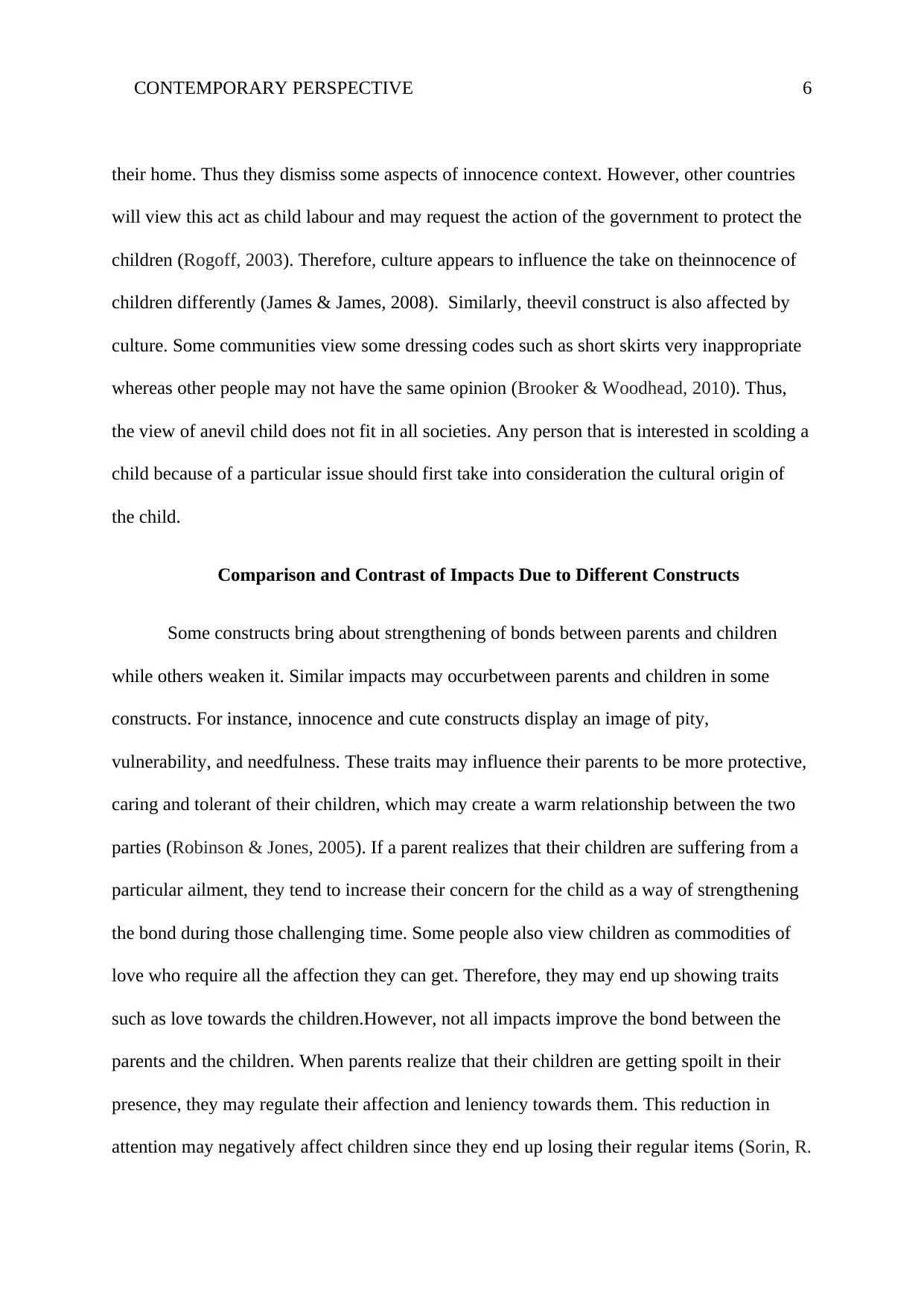
CONTEMPORARY PERSPECTIVE 6
their home. Thus they dismiss some aspects of innocence context. However, other countries
will view this act as child labour and may request the action of the government to protect the
children (Rogoff, 2003). Therefore, culture appears to influence the take on theinnocence of
children differently (James & James, 2008). Similarly, theevil construct is also affected by
culture. Some communities view some dressing codes such as short skirts very inappropriate
whereas other people may not have the same opinion (Brooker & Woodhead, 2010). Thus,
the view of anevil child does not fit in all societies. Any person that is interested in scolding a
child because of a particular issue should first take into consideration the cultural origin of
the child.
Comparison and Contrast of Impacts Due to Different Constructs
Some constructs bring about strengthening of bonds between parents and children
while others weaken it. Similar impacts may occurbetween parents and children in some
constructs. For instance, innocence and cute constructs display an image of pity,
vulnerability, and needfulness. These traits may influence their parents to be more protective,
caring and tolerant of their children, which may create a warm relationship between the two
parties (Robinson & Jones, 2005). If a parent realizes that their children are suffering from a
particular ailment, they tend to increase their concern for the child as a way of strengthening
the bond during those challenging time. Some people also view children as commodities of
love who require all the affection they can get. Therefore, they may end up showing traits
such as love towards the children.However, not all impacts improve the bond between the
parents and the children. When parents realize that their children are getting spoilt in their
presence, they may regulate their affection and leniency towards them. This reduction in
attention may negatively affect children since they end up losing their regular items (Sorin, R.
their home. Thus they dismiss some aspects of innocence context. However, other countries
will view this act as child labour and may request the action of the government to protect the
children (Rogoff, 2003). Therefore, culture appears to influence the take on theinnocence of
children differently (James & James, 2008). Similarly, theevil construct is also affected by
culture. Some communities view some dressing codes such as short skirts very inappropriate
whereas other people may not have the same opinion (Brooker & Woodhead, 2010). Thus,
the view of anevil child does not fit in all societies. Any person that is interested in scolding a
child because of a particular issue should first take into consideration the cultural origin of
the child.
Comparison and Contrast of Impacts Due to Different Constructs
Some constructs bring about strengthening of bonds between parents and children
while others weaken it. Similar impacts may occurbetween parents and children in some
constructs. For instance, innocence and cute constructs display an image of pity,
vulnerability, and needfulness. These traits may influence their parents to be more protective,
caring and tolerant of their children, which may create a warm relationship between the two
parties (Robinson & Jones, 2005). If a parent realizes that their children are suffering from a
particular ailment, they tend to increase their concern for the child as a way of strengthening
the bond during those challenging time. Some people also view children as commodities of
love who require all the affection they can get. Therefore, they may end up showing traits
such as love towards the children.However, not all impacts improve the bond between the
parents and the children. When parents realize that their children are getting spoilt in their
presence, they may regulate their affection and leniency towards them. This reduction in
attention may negatively affect children since they end up losing their regular items (Sorin, R.

CONTEMPORARY PERSPECTIVE 7
2005). In addition, if the parent decides to punish a child because of their wrongdoings, they
may end up hating their parent instead. This scenario applies to both evil and out of control
constructs because they both fail to observe the required behaviour measures.
Contrast among the Different Constructs
There also exists some contrast between the five different constructs. One of the first
difference observable between the groups is the manner in which an adult views the children
in the various contexts. For example, in the context of innocence, the adults see the children
as vulnerable, incompetent and helpless hence, requiring their attention. On the other hand,
cute construct displays children as objects requiring love. They find them adorable,
determined but dependent (Bowes, Grace & Hodge, 2012). The children’s determination
reminded the adults of their younger years when they faced similar challenges. Those
memories are the reason why they strive to protect the children. For the case of “out of
control” children, adults regard them negatively as violent, mischievous, and danger to their
future. They see spoilt children as overly controlling and demanding causing them to
decrease the bonding. Finally, for evil children, adults perceive them as threats to themselves
and the society (Bowes, Grace & Hodge, 2012). At times, cases occur such as when one child
beats the other during an argument. Such children will face severe action from both the
school and the parent. The overall impact will be reducing love and care while replacing it
with regular punishment to rectify the behaviour.
Lastly, the contrast in the future effect of different constructs should be studied. In
most cases, the nature and behaviours of an adult are usually dependent on the childhood
experiences. First, consider the scenario of an innocent child that undergoes torture during
child labour in the hands of authorities at the time. When such a child grows up, they will
2005). In addition, if the parent decides to punish a child because of their wrongdoings, they
may end up hating their parent instead. This scenario applies to both evil and out of control
constructs because they both fail to observe the required behaviour measures.
Contrast among the Different Constructs
There also exists some contrast between the five different constructs. One of the first
difference observable between the groups is the manner in which an adult views the children
in the various contexts. For example, in the context of innocence, the adults see the children
as vulnerable, incompetent and helpless hence, requiring their attention. On the other hand,
cute construct displays children as objects requiring love. They find them adorable,
determined but dependent (Bowes, Grace & Hodge, 2012). The children’s determination
reminded the adults of their younger years when they faced similar challenges. Those
memories are the reason why they strive to protect the children. For the case of “out of
control” children, adults regard them negatively as violent, mischievous, and danger to their
future. They see spoilt children as overly controlling and demanding causing them to
decrease the bonding. Finally, for evil children, adults perceive them as threats to themselves
and the society (Bowes, Grace & Hodge, 2012). At times, cases occur such as when one child
beats the other during an argument. Such children will face severe action from both the
school and the parent. The overall impact will be reducing love and care while replacing it
with regular punishment to rectify the behaviour.
Lastly, the contrast in the future effect of different constructs should be studied. In
most cases, the nature and behaviours of an adult are usually dependent on the childhood
experiences. First, consider the scenario of an innocent child that undergoes torture during
child labour in the hands of authorities at the time. When such a child grows up, they will
Paraphrase This Document
Need a fresh take? Get an instant paraphrase of this document with our AI Paraphraser
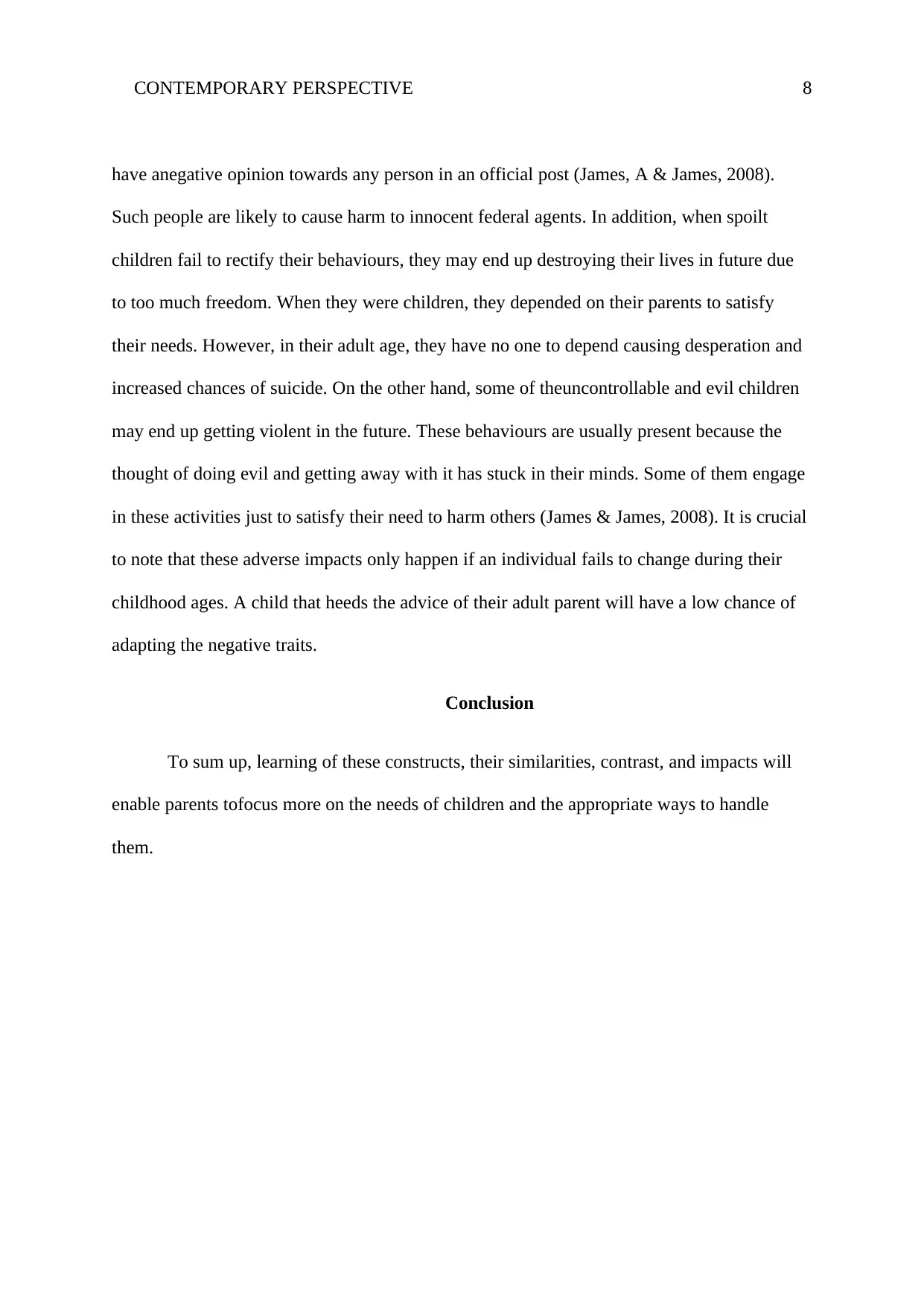
CONTEMPORARY PERSPECTIVE 8
have anegative opinion towards any person in an official post (James, A & James, 2008).
Such people are likely to cause harm to innocent federal agents. In addition, when spoilt
children fail to rectify their behaviours, they may end up destroying their lives in future due
to too much freedom. When they were children, they depended on their parents to satisfy
their needs. However, in their adult age, they have no one to depend causing desperation and
increased chances of suicide. On the other hand, some of theuncontrollable and evil children
may end up getting violent in the future. These behaviours are usually present because the
thought of doing evil and getting away with it has stuck in their minds. Some of them engage
in these activities just to satisfy their need to harm others (James & James, 2008). It is crucial
to note that these adverse impacts only happen if an individual fails to change during their
childhood ages. A child that heeds the advice of their adult parent will have a low chance of
adapting the negative traits.
Conclusion
To sum up, learning of these constructs, their similarities, contrast, and impacts will
enable parents tofocus more on the needs of children and the appropriate ways to handle
them.
have anegative opinion towards any person in an official post (James, A & James, 2008).
Such people are likely to cause harm to innocent federal agents. In addition, when spoilt
children fail to rectify their behaviours, they may end up destroying their lives in future due
to too much freedom. When they were children, they depended on their parents to satisfy
their needs. However, in their adult age, they have no one to depend causing desperation and
increased chances of suicide. On the other hand, some of theuncontrollable and evil children
may end up getting violent in the future. These behaviours are usually present because the
thought of doing evil and getting away with it has stuck in their minds. Some of them engage
in these activities just to satisfy their need to harm others (James & James, 2008). It is crucial
to note that these adverse impacts only happen if an individual fails to change during their
childhood ages. A child that heeds the advice of their adult parent will have a low chance of
adapting the negative traits.
Conclusion
To sum up, learning of these constructs, their similarities, contrast, and impacts will
enable parents tofocus more on the needs of children and the appropriate ways to handle
them.
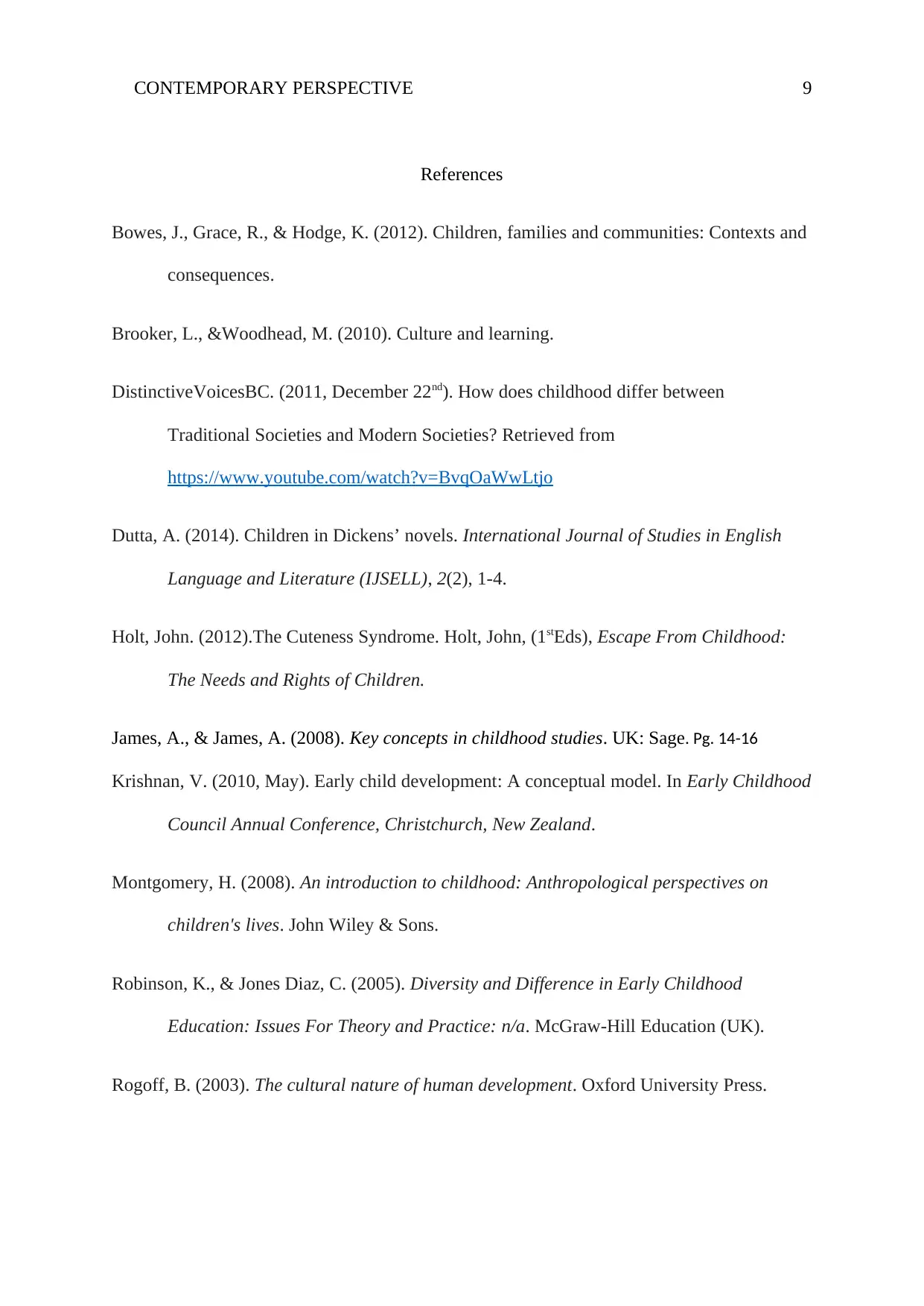
CONTEMPORARY PERSPECTIVE 9
References
Bowes, J., Grace, R., & Hodge, K. (2012). Children, families and communities: Contexts and
consequences.
Brooker, L., &Woodhead, M. (2010). Culture and learning.
DistinctiveVoicesBC. (2011, December 22nd). How does childhood differ between
Traditional Societies and Modern Societies? Retrieved from
https://www.youtube.com/watch?v=BvqOaWwLtjo
Dutta, A. (2014). Children in Dickens’ novels. International Journal of Studies in English
Language and Literature (IJSELL), 2(2), 1-4.
Holt, John. (2012).The Cuteness Syndrome. Holt, John, (1stEds), Escape From Childhood:
The Needs and Rights of Children.
James, A., & James, A. (2008). Key concepts in childhood studies. UK: Sage. Pg. 14-16
Krishnan, V. (2010, May). Early child development: A conceptual model. In Early Childhood
Council Annual Conference, Christchurch, New Zealand.
Montgomery, H. (2008). An introduction to childhood: Anthropological perspectives on
children's lives. John Wiley & Sons.
Robinson, K., & Jones Diaz, C. (2005). Diversity and Difference in Early Childhood
Education: Issues For Theory and Practice: n/a. McGraw-Hill Education (UK).
Rogoff, B. (2003). The cultural nature of human development. Oxford University Press.
References
Bowes, J., Grace, R., & Hodge, K. (2012). Children, families and communities: Contexts and
consequences.
Brooker, L., &Woodhead, M. (2010). Culture and learning.
DistinctiveVoicesBC. (2011, December 22nd). How does childhood differ between
Traditional Societies and Modern Societies? Retrieved from
https://www.youtube.com/watch?v=BvqOaWwLtjo
Dutta, A. (2014). Children in Dickens’ novels. International Journal of Studies in English
Language and Literature (IJSELL), 2(2), 1-4.
Holt, John. (2012).The Cuteness Syndrome. Holt, John, (1stEds), Escape From Childhood:
The Needs and Rights of Children.
James, A., & James, A. (2008). Key concepts in childhood studies. UK: Sage. Pg. 14-16
Krishnan, V. (2010, May). Early child development: A conceptual model. In Early Childhood
Council Annual Conference, Christchurch, New Zealand.
Montgomery, H. (2008). An introduction to childhood: Anthropological perspectives on
children's lives. John Wiley & Sons.
Robinson, K., & Jones Diaz, C. (2005). Diversity and Difference in Early Childhood
Education: Issues For Theory and Practice: n/a. McGraw-Hill Education (UK).
Rogoff, B. (2003). The cultural nature of human development. Oxford University Press.
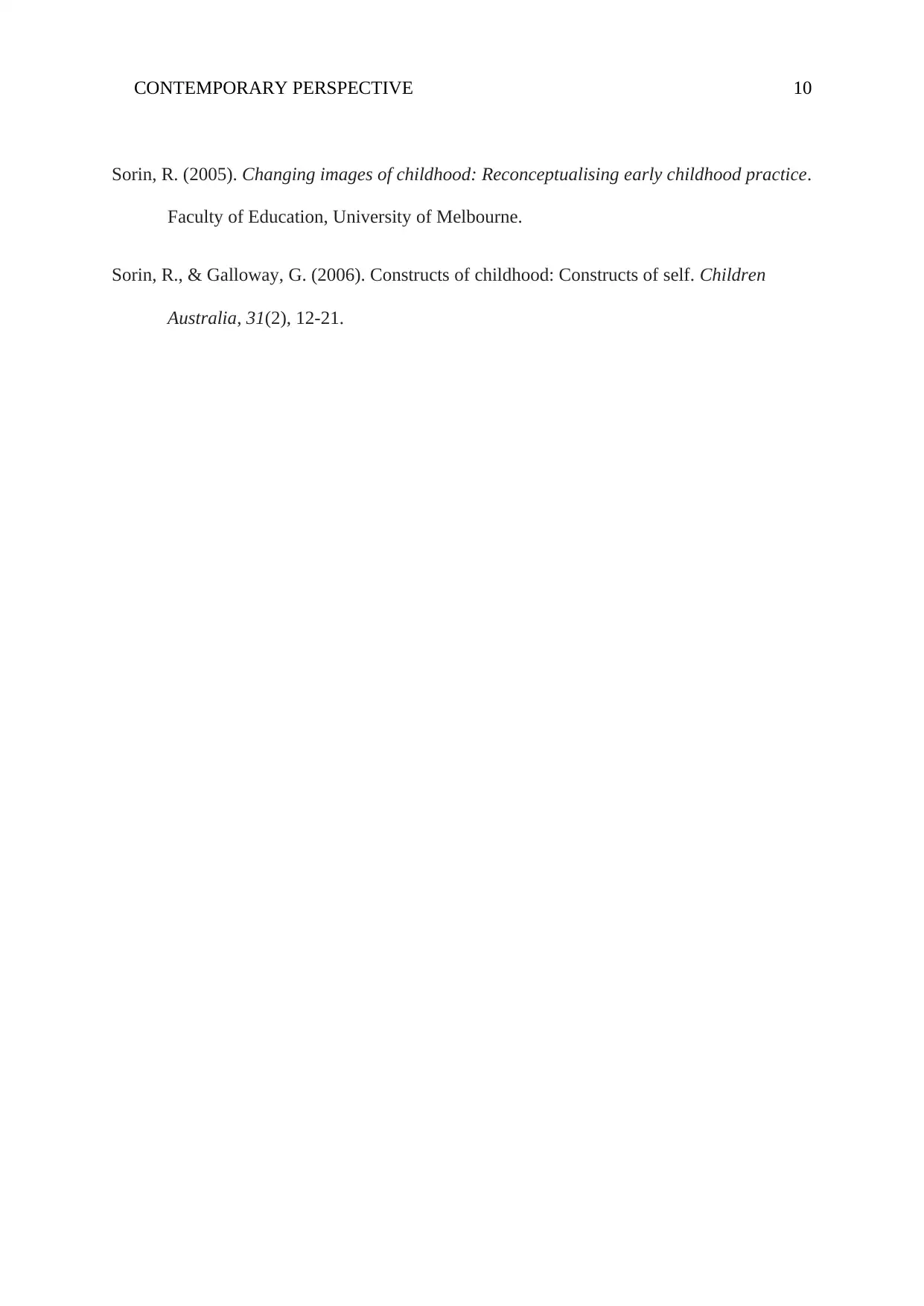
CONTEMPORARY PERSPECTIVE 10
Sorin, R. (2005). Changing images of childhood: Reconceptualising early childhood practice.
Faculty of Education, University of Melbourne.
Sorin, R., & Galloway, G. (2006). Constructs of childhood: Constructs of self. Children
Australia, 31(2), 12-21.
Sorin, R. (2005). Changing images of childhood: Reconceptualising early childhood practice.
Faculty of Education, University of Melbourne.
Sorin, R., & Galloway, G. (2006). Constructs of childhood: Constructs of self. Children
Australia, 31(2), 12-21.
1 out of 10
Your All-in-One AI-Powered Toolkit for Academic Success.
+13062052269
info@desklib.com
Available 24*7 on WhatsApp / Email
![[object Object]](/_next/static/media/star-bottom.7253800d.svg)
Unlock your academic potential
© 2024 | Zucol Services PVT LTD | All rights reserved.

